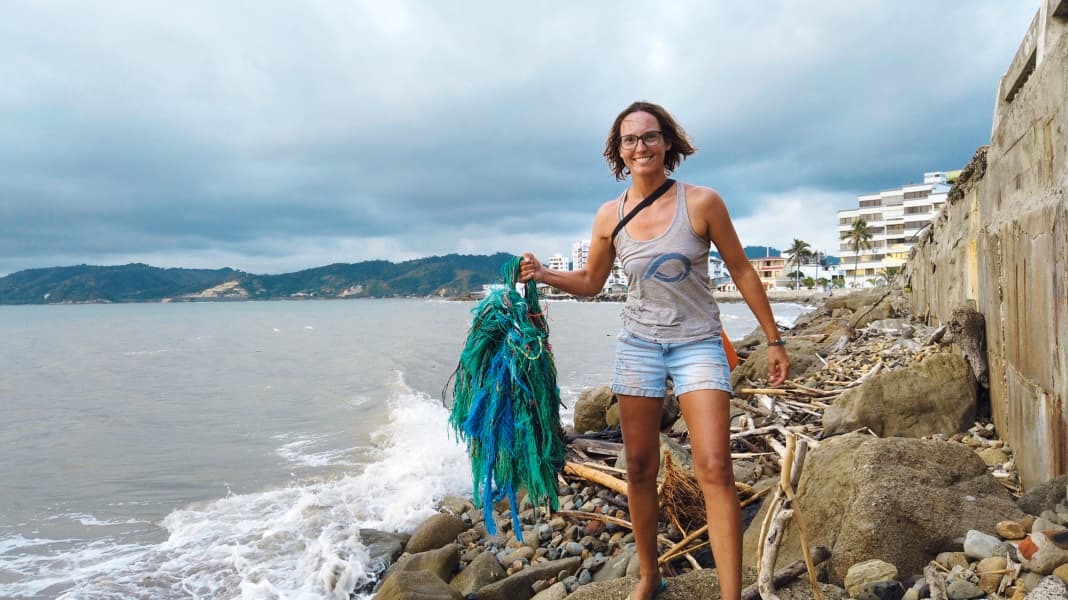From sailing vlogger to environmentalist: Nike Steiger on her recycling project

YACHT: Nike, when did it click for you that you wanted to do something?
Nike Steiger:I saw more and more plastic lying on the beaches, which really shocked me. I started picking it up. When you live on a boat, you think more about consumption - of electricity, water and also plastic. In the end, I founded the "InMocean" initiative with a friend, with which we are committed to the fight against plastic waste.
How do you do that?
In the beginning, we organised beach clean-ups. Then we built machines based on an open-source template with which you can shred your own cleaned plastic waste and mould it into new products - even on board!
But that's not all, is it?
No, our aim is to build infrastructure in remote coastal regions that enables locals to collect plastic waste and process and sell it into household products such as bowls, furniture or lamps. In this way, we want to raise awareness of old plastic as a resource and promote its reuse.
Does that work?
Yes, the third workspace is currently being set up in Mexico. The donated recycling machines have already arrived. Everything is still funded by donations. We are working with local organisations that are anchored and motivated on the ground.
Is only marine litter washed ashore used?
There are two sources: firstly, plastic collected on the beach. But also household plastics, which are not recycled at all in the Central American regions where we are travelling. They are incinerated or thrown away. We work with polypropylene and polythene. This is shredded, heated and remoulded.
What role does the recycling fleet you set up play in this?
The fleet consists of a total of seven yachts of sailing vloggers, including myself, who are travelling to different parts of the world, holding workshops for locals with the recycling machines and creating reach for the topic via their YouTube channels. In this way, we want to kill two birds with one stone.
We want to raise awareness of old plastic as a resource and promote its reuse"
Does the concept work?
In the first year, 55 workshops were organised in eight countries. People experience how a new product is created from waste. You can tell that this has a real "aha" effect on people's minds. Children in particular queue up. It's cool to see how the new knowledge they've gained becomes ingrained in them. The next time they go to the beach, they shout: "Nike, you can make something out of this!" That's great. For the adults, it's more the financial incentive of being able to sell the products. For example, in the form of jewellery for tourists.
Do you make sure you consume less plastic yourself?
I don't live plastic-free, that's difficult. But I don't buy new clothes, for example. And I also try to repair electronic devices instead of buying new ones. Fortunately, as a sailor you have the opportunity to travel with a relatively small carbon footprint. However, the recycling project has also changed my perception a little.
In what way?
When you have a machine like this on board, you get a new perspective on beach rubbish. I see a piece and think, that's a pretty turquoise colour - what you could do with it!(laughs)
Further topics in the sustainability special:
- 25 tips to help you sail more environmentally friendly
- These projects are available for marine conservation
- Sailing yacht vs. motorboat: which model is more sustainable?
- Boatbuilding ecolution: These shipyards are working on sustainable concepts
- Shipyard portrait Greenboats: Boats made of flax and components for Boris Herrmann
- Sustainable fashion: oilskins and other functional clothing - the best products
- Boat recycling: the never-ending story of GRP
- Sail recycling: not just stylish bags- what happens to old cloth
- "Losing is not an option"- Boris Herrmann on sustainability in motorsport
- Sustainable management: Wooden boats in charter operations
- Equipment: Every sailor should reach for these green alternatives
- Drinking water on board: you can filter water correctly using these methods
- Baltic Sea: How does a harbour become sustainable?
- Research yachts: Climate protectors under sail
- Pallets, bottles, flip-flops: creative recycling ideas in boatbuilding
- Monsoon 31: Greenfit instead of refit, what does that mean for the 50-year-old Hallberg-Rassy?
- "Nomade des Mers": a catamaran as a low-tech laboratory
- Self-build yacht "Ya": Totally self-sufficient on a trip around the world
- Sustainable boat project: 55-foot catamaran made from recycled aluminium
- The Schwörer family and the "Pachamama": On a long voyage for climate protection

